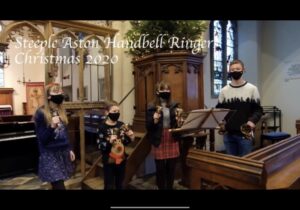Christmas is the time when some changeringers bite the bullet and do some tune ringing. Out come the carol arrangements and the purists grumble that using numbers is not real music. No, but it’s an inclusive means to an end. I am going to teach my work colleagues to ring Silent Night on Ringing Room, having failed to find a decent arrangement of what is of course the best of all Christmas songs “I want a Hippopotamus for Christmas.” Watch this video at your peril as the tune will stick in your mind forever!
Lots of ringers have turned to handbell ringing in lockdown as it has provided more opportunities. The Brumdingers regularly rang handbells outside, and just before it got too cold and too dark to ring outside after school we had started ringing Christmas carols to provide some variety. We left room for improvement. Proof of what can be done with practice comes from the young ringers of Steeple Aston in Oxfordshire, who give this lovely demonstration.
Provided we don’t all go back into lockdown after Christmas, young ringers practices can start again in England at least in the New Year. This is using government guidance that recognises the importance of children’s activities out of school. Detailed guidance is now on the CC website and linked from the Bellboard ‘Virtual Hub’. It’s still not a free-for-all practice as we remember them, but should help those who have been working hard to retain their young ringers during lockdown, youngsters who might otherwise start drifting off into other interests.
The Virtual Hub was what brought the North American Guild’s ‘Online GatheRing’ to my attention, and I was pleased to drop in. This really shows what you can do if you’re well organised. There were 16 sessions across eight Ringing Rooms and Discord channels, with activities ranging from the social (pub, quiz, games) to the intense (Spliced Surprise Major). I was able to join in some surprise major ringing in between my garlic bread starter and Saturday night pizza in front of Strictly.
Following last week’s comment on whether we say that we are bellringers on our CVs (if we have them) I followed Tim Mitchell’s suggestion of introducing work contacts to Ringing Room by posting my interest in bell ringing on LinkedIn, along with Kemp Brinson’s brilliant video introduction to Ringing Room, with an invitation to people to be taught to ring Plain Hunt. Early days but my post has been viewed over 700 times and shared. A Dutch colleague who lives in Perth WA was quite surprised when I told him I had visited Perth on more than one occasion to ring bells and visit the Lucky Shag.
Tim’s longer term idea is to take a mobile belfry to large companies and run team building/recruitment activities. If you work for a large company, maybe one with multiple sites or a campus, do you think that if a mobile belfry was erected in the car park or courtyard, colleagues might be encouraged to have a go and form a ringing group? It might be something we pilot in a few places next year when we can.
The Women in Ringing project has come to the end of its first phase. Apparently the special issue of the Ringing World sold a lot of extra copies and even some new subscriptions were taken out as a result of it. The volume of positive and supportive comments was significant and far outweighed any of the to-be-expected criticisms about the subject of gender. The working group is now developing plans to build on the project, with ideas around mentoring, guidance and learning materials, pledges and commitments to do things differently, and generally maintaining awareness of the subject.
When you ring the 5th to peal attempts at Birmingham Cathedral as I was prone to do pre-lockdown, you really take one for the team on a cold day – the wind whistles in and can even move the rope. However, good airflow through the room keeps the back bell ringers from overheating (so they can ring faster) but also keeps all ringers’ concentration levels high (so they can ring longer). More work is being done by the Covid guidance team on CO2 measurements as a means of assessing how well ventilated towers are, leading in turn to better understanding of how long we will be able to ring for in different types of towers. Expertise in monitoring ventilation in offices and labs using CO2 as a measure has been added to the team.
From time to time people send me their newsletters, particularly when they are justifiably proud of them. The latest submission is the Farnham District Newsletter which is another amazing production, managing to fill 28 pages of copy from three months of no ringing. There is a particularly interesting table surveying the level of activity in the District’s towers, with about half using Zoom and Ringing Room to keep practicing. And laudable reference to Council initiatives! Are 50% or more of the towers in your association, branch or district staying active with online activities?
The first Survival and Recovery newsletter has gone out (available again from the Virtual Hub) and has already uncovered stories of what ringers, districts and associations are doing. The joint ART/CC team has an idea of building a network of ‘Recovery Champions’ in different areas who will absorb the different ideas being banded about and help to see what will work in their area. There are already people doing a lot, but also areas that seem a bit dead, and which might stay that way if we’re not careful. Could you be a Recovery Champion?
Thankfully at the time of writing we will still have guidance in place for ringing over Christmas, at least in England if not in other countries as well. 2020 will be a year to forget. Let’s hope that in 2021 we can Come Back Better.
Happy Christmas
Simon Linford
President CCCBR

